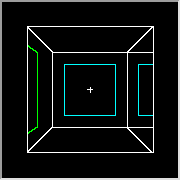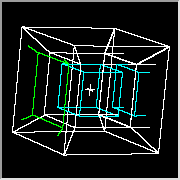Home
> 4D Maze Game
Download
|
The Idea
In the Maze
> Notes
Reference
The Fourth Dimension
Can You See It?
|
The Tesseract
The Tesseract, Part Two
The Hexadecachoron
|
How Much Space Is There?
Rotations
|
> How to Point |
Volumes
Walls Are Opaque
|
Some Mathematics
Bibliography
How to Point
One thing I guess I haven't said about the turn keys is that together they act like a three-dimensional mouse that you can use to point the crosshairs in any direction (if you turn off align mode), just as you can use a two-dimensional mouse to point in any direction in a three-dimensional game.Sometimes a three-dimensional game will have a slide-on key that lets you use the mouse to slide instead of turn. The default slide keys effectively do the same thing: if you hold down the Alt key you can use the three-dimensional mouse to slide.
The default spin keys effectively do the same thing for spin, but in a messed-up way. The problem is, it's not obvious which mouse motions should correspond to which spins. The default correspondence is not natural, it is just an expedient extension of the three-dimensional spin keys. Surprisingly, there are some natural correspondences; in fact, there are exactly two, both based on orthogonal spin types. You can try them if you like, but I found them very confusing.
So much for the three-dimensional mouse.
Now, to get a better idea of how to point, I think it will help to have a picture to look at. So, here's a passage leading to the right, from back when we looked at side passages.


That cube in the middle, remember, is the wall in front of us. From here, we can move the three-dimensional mouse and point not only at the other walls, or down the passage, but at any individual point within the cube. In fact, we already did some of that when we looked at the various parts of the tesseract.
There's another side to the equation, by the way: you can turn and look at any individual point, but you can't really tell which point you're looking at unless you enable stereo mode.
Now I'd like to digress for a moment. As three-dimensional people, it's easy for us to look at the picture above and think that the cube is the square we're standing in, and that the partial cube to the right is the passage. It is not so! The cube is a wall we're looking at, not a square we're standing in, and the partial cube is another wall, the back wall of the passage. If we turned 90 degrees downward, we'd still be in the same place, and the passage would still be to our right, but we would be looking at different walls—at the floor, in fact. In short, the crosshairs indicate where you're looking, not where you are.
Finally, here is an exercise in pointing that I thought of. On the maze tab, set the number of dimensions to one and the size to some reasonable value (say, ten) so that the maze will be just a single long passage. Start a new game, turn off align mode, then practice flying back and forth down the passage.
Even better, practice weaving left and right as you fly, ideally without running into the walls; also practice weaving up and down, and in and out.
Here are some things you may notice.
- If you're pointing at a wall, and you move forward without turning, you will run into the wall you were pointing at. (Duh!) Thus, if you want to go to the end of a passage, you need to point at the small cube that is the back wall.
- When the wall is far away, you won't be able to see it clearly. In that case, you need to aim at the vanishing point where the lines converge.
- Similarly, if you want to weave to the left, you need to point at one of the truncated pyramids that form the left wall of the passage. (Of course the walls are really cubes, they just look like truncated pyramids because of the perspective.)
- When you get close to a (side) wall, the wall will start to look flat. I don't know how else to describe the effect, but you'll know it when you see it, and it is a clue that you should turn the other way. It is hard to tell when the in and out walls are getting flat.
Once you get used to flying down passages, you can effectively add a few obstacles by setting up a 10 × 2 maze—or a 10 × 2 × 2 × 2 maze, for that matter. The result is vaguely like that part of the original Star Wars arcade game where you fly down the trench.